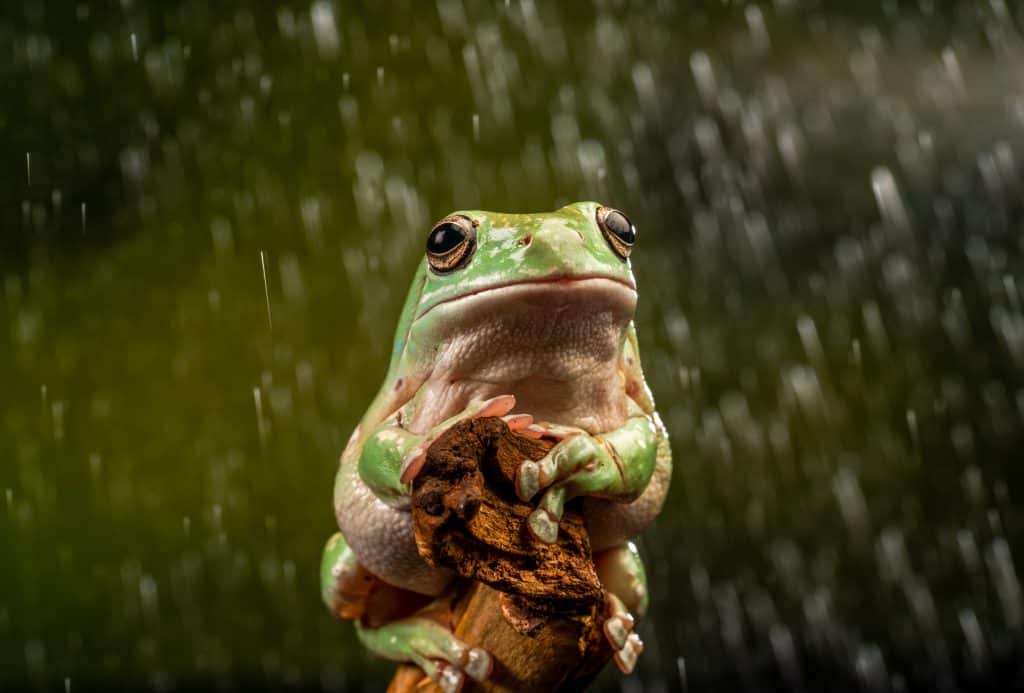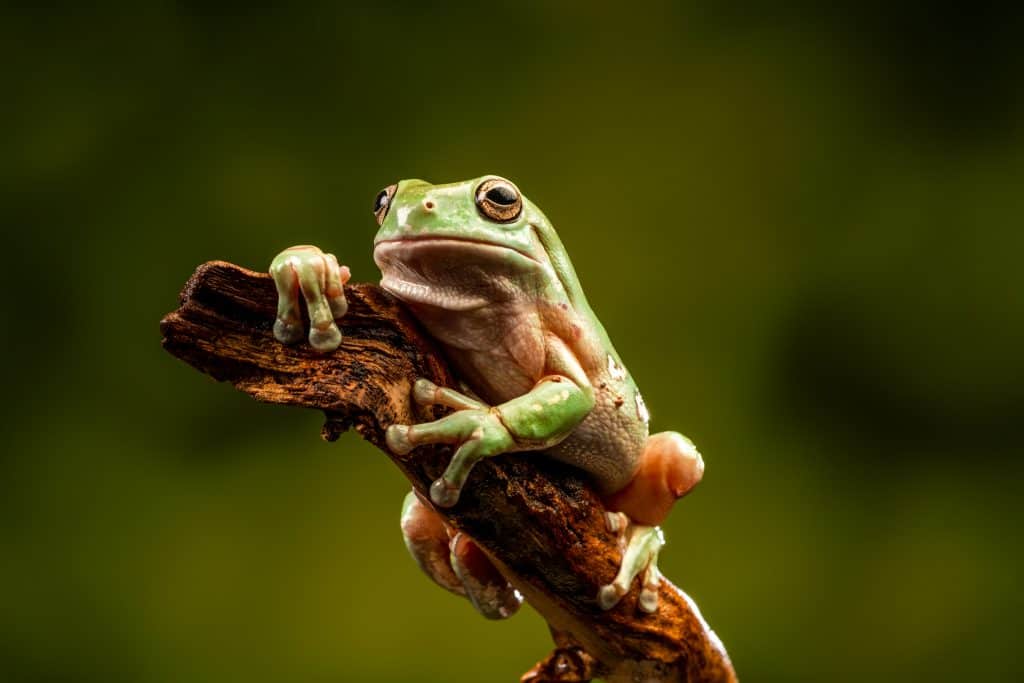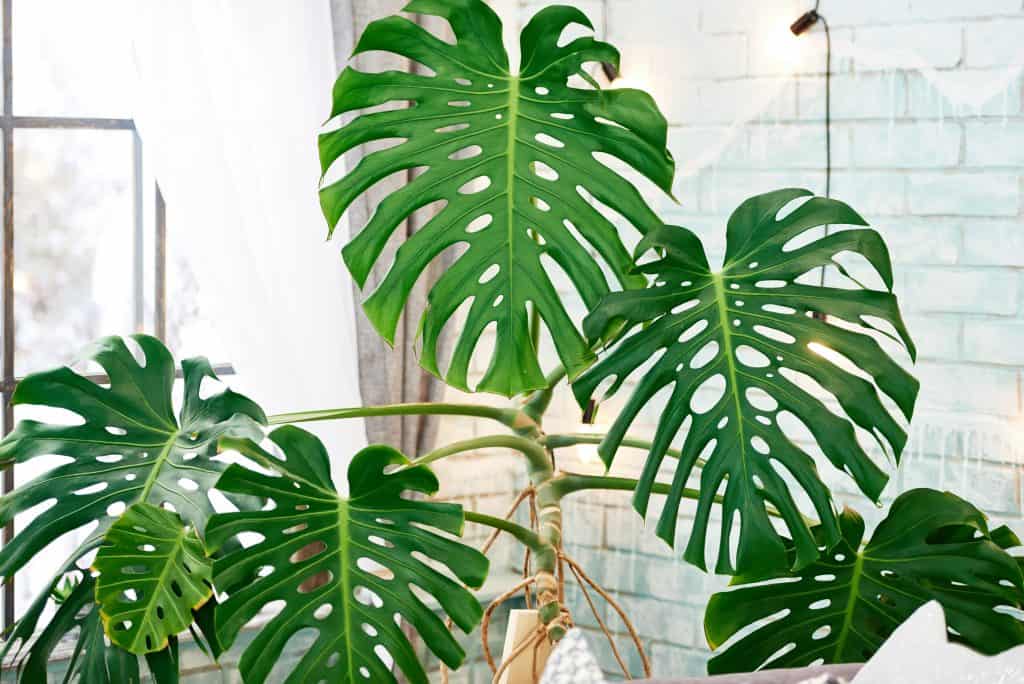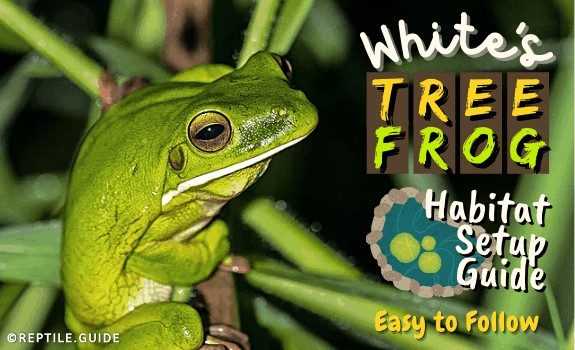In This Article
In Short
White’s tree frogs are great amphibians for novice amphibian keepers. They’re one of the most popular frog species in the pet trade – and for good reason!
White’s tree frog habitat requirements are easy to meet (relative to other amphibians).
These large, pudgy tree frogs do well in groups and have no specific lighting requirements.
They also have lower humidity requirements than other amphibians.
Together, these factors allow White’s tree frogs to be comfortable in a fairly simple enclosure setup.
Just ensure that your frogs have plenty of room to climb and to hide!
What You’ll Learn
In this article, you’ll learn:
- About the natural habitat of White’s tree frogs
- Temperature, humidity, and other environmental requirements
- How to choose, prepare, and maintain a White’s tree frog enclosure
- How to select decor that is functional as well as aesthetically pleasing
- How to prevent stressing frogs when introducing them to their new home
- …and much more!
White’s Tree Frog Background Information
White’s tree frogs are native to Australia, New Guinea, and Indonesia.
They’re a relatively large tree frog species – growing up to 4.5 inches (snout to vent).
These frogs thrive on an insectivorous diet. They can occasionally eat small mammals and reptiles, as well.
As their name suggests, White’s tree frogs are arboreal animals. Their large, sticky toe pads allow them to climb most surfaces with ease.
Living in the forest canopy allows them to evade ground predators and lap up moisture from rain and condensation.
The skin of White’s tree frogs is coated in specialized lipids and proteins to prevent moisture from escaping.
This adaptation allows them to live further from water (relative to other amphibian species). They do still require access to water bodies in which to lay their eggs.
White’s Tree Frog Habitat (in the Wild)
White’s tree frogs thrive in a variety of habitats throughout their native range.
They usually live in forests and other woodland areas.
Eucalyptus trees provide ideal microhabitat conditions for White’s tree frogs.
These trees accumulate pools of water, providing a safe and sheltered water source – and a place to lay their eggs.
Eucalyptus stands are a common sight throughout much of coastal Australia.
Humid, rainy conditions are ideal for this species.
Still, White’s tree frogs can also inhabit seasonally dry forests. This ability is in part due to their skin being less permeable than that of other frogs.
During the dry season, White’s tree frogs can estivate.
For the White’s tree frog, this process involves cocooning themselves in a gooey mixture of dead skin and mucus to prevent moisture loss.
Urban areas – though not ideal habitat – also provide many places for White’s tree frogs to thrive.
Australian suburbanites may find these frogs hanging around water pipes, dripping A/C units, and even in bathrooms!
Many sources claim that White’s tree frogs are highly comfortable around humans. Though it’s true that they are adaptable and can colonize urban habitats, this may not be ideal for their health.
Data from recent studies suggest that noisy urban environments may impact fertility and stress levels in White’s tree frogs.
They’re also often found in dense vegetation along waterways, such as creeks and rivers.
When creating an artificial habitat for your frogs, try to simulate natural conditions as much as possible.
Your frogs will thank you by staying healthy and active – and retaining their vivid coloration!
Creating the Perfect White’s Tree Frog Habitat
There are many key aspects to constructing a frog enclosure. For the White’s tree frog, the most important aspects of this process are as follows:
- Choosing your enclosure -size, shape, and construction
- Preparing your enclosure – placement and gentle cleaning
- Maintaining a hospitable environment – humidity and temperature
- Selecting appropriate substrate – to maintain humidity and avoid impaction
Choosing an Enclosure
Before purchasing an enclosure for White’s tree frogs, ask yourself the following questions:
- Will my frogs be able to escape?
- Will they have sufficient ventilation?
- Will my tree frogs have enough space to climb and explore?
- Will I be able to maintain a constant temperature and humidity?
Tree frogs are escape artists. Ensure that any enclosure you choose has a tight-fitting lid – and remember to close it!
Frogs can develop respiratory issues in a poorly ventilated vivarium. Ensure that your habitat lid has a ventilation screen.
White’s tree frogs are fairly large amphibians and require a decent amount of space.
Insufficient space (or overcrowding) may lead to stress-related health issues. You may also find it difficult to keep your enclosure clean.
As a social species, White’s tree frogs should ideally live in small groups. 20 gallons is the minimum enclosure size recommended for this species.
This size will allow one to four frogs to coexist comfortably. A larger enclosure – if available – is still preferable.
Enclosure size, while important, is not the only factor to consider here. The shape is also important, the goal being to maximize vertical space.
Ideally, your White’s tree frog enclosure should be taller than it is wide. This orientation allows your frogs to climb to their hearts’ content.
Hexagonal enclosures are ideal for climbing frogs. Taller rectangular enclosures can also make good choices.
Glass vivariums make it easier to maintain temperature and humidity. These are usually the best bet for amphibian keepers.
Acrylic is a cheaper and more lightweight alternative to glass but may overheat more easily.
Enclosure Preparation
Gently clean any enclosure you purchase to remove dust. This dust may contain chemical residues and would-be pathogens.
Avoid using any chemical cleaners, as these will harm your frogs later on. Instead, wipe surfaces down with distilled water.
Place your enclosure on a sturdy surface somewhere in your home. Avoid direct sunlight and dry areas. These factors will make it harder to maintain a hospitable environment for your frogs.
Placing your enclosure in a room with windows will help to maintain a natural day/night cycle for your frog.
Temperature
White’s tree frogs are adapted for a tropical climate.
They require a constant temperature range of 24-26 °C (75-80 °F).
Creating a temperature gradient will allow your frog to freely regulate its body temperature.
Do this by attaching a heat mat to an exterior vivarium wall. Ensure that your heat mat is regulated using a thermostat to prevent overheating.
Humidity
White’s tree frogs require constant humidity of around 50% to prevent their sensitive skin from drying out.
Mist your enclosure daily with distilled or spring water. Some keepers may prefer to invest in an automatic misting system for added convenience.

Keep the substrate slightly damp to the touch. Avoid over misting your vivarium. Excessive moisture can lead to mold and bacteria growth.
Humidity maintenance can be made easier by setting up selecting an appropriate substrate. We’ll discuss this in detail in the next section.
Substrate
The substrate is the material that lines the base of your vivarium.
It works to retain moisture, maintain cleanliness, and enhance the overall appearance of an enclosure.
Choosing an appropriate substrate is vital for the health of your frogs.
The main factors to consider when selecting a substrate are particle size and moisture absorbance.
Substrate is often ingested accidentally during feeding. This factor can create a risk of choking or intestinal impaction.
Select a substrate with a smaller particle size to minimize these risks.
Fine particulate soil or ground coconut husk are among the most popular substrate choices for White’s tree frogs. These options provide a natural aesthetic and retain moisture well.
Less natural-looking options include foam vivarium liners or even paper towels. Both are easy to clean and moisture absorbent. Paper towels are also cheap to replace.
With most organic substrates, decomposition and waterlogging can be an issue. Layering is an excellent way to improve drainage and humidity control.
There are typically three layers to include for an effective vivarium substrate:
- Drainage layer – Allows excess water to drain away from the main substrate. Prevents bacteria and mold growth. Usually consists of washed gravel, but commercial options are also available. Use a pointed waste remover or siphon to remove excess water during regular tank maintenance.
- Primary substrate – Located above the drainage layer, sometimes separated by a fine, non-toxic mesh. Serves to retain moisture and heat and to absorb waste. Coconut husk or fine soil are good options.
- Top layer – Usually a combination of sphagnum/sheet moss and leaf litter. Covers primary substrate to help with moisture retention. Can also add to the natural appearance of the terrarium. Note that the top layer may break down and need to be replaced frequently.
Expert Tip: Be especially careful with substrate choices when layering. Always ensure that mosses are large enough to avoid excessive ingestion. Large sheet mosses are great for this purpose. Never allow frogs to come into contact with gravel.
Lighting
Lighting serves a few different purposes for amphibians and reptiles:
- Providing a heat source
- Promoting vitamin D3 production
- Providing daily activity and sleep cues
- Of course, lighting also allows you to see your frog’s vivid coloration.
Luckily, it’s easy to set up vivarium lighting for the White’s tree frog that fulfills each of these needs.
White’s tree frogs are nocturnal. They have no specific UV lighting requirements, provided that you regularly offer vitamin D3 supplements.
In the wild, they are exposed to some UVB during the day. It may be beneficial for your frogs to receive some UVB, though it’s not essential.
It is essential to provide natural day-night cycles. A 12 hour on/off cycle allows your frog to maintain a natural pattern of sleep and activity.
Constant lighting or darkness will confuse and stress your animals.
Live plants will likely need UV lighting. Ensure that any light bulbs used are amphibian-safe before installing them.
Fluorescent lights are a great choice to highlight the color of your frogs during the day and provide UVA and UVB for frogs and plants alike.
T8 and T12 lights are ideal for amphibians, as they produce little excess heat.
Incandescent or halogen bulbs are a poor choice for White’s tree frogs. They generate a lot of heat, which can cause frogs’ skin to dry out.
Food and Water Dishes
Every White’s tree frog enclosure should contain either two or three dishes:
- Water
- Calcium
- Food (optional)
Frogs absorb water through their skin rather than by drinking. Your tree frog will absorb most of its water from leaves or vivarium glass after misting.
Still, keep a water bowl filled in your vivarium at all times. It will allow your frog constant access to hydration and slightly raise the overall humidity of the enclosure.
Calcium is an essential nutrient for frogs. It helps to maintain bone and nervous system health.
A bowl of calcium should always be present in your frog’s enclosure. Similar to the water bowl, this allows your frog to access calcium whenever it is needed.
Calcium should also be added to foods regularly by dusting. For more information about nutrition and supplements, read our article on the White’s tree frog diet.
A food bowl is optional for White’s tree frogs. Most feeder insects may be allowed to wander around the enclosure.
Other foods (such as worms, grubs, and canned insects) may try to burrow to safety or make a mess of your frog’s home!
Placing these foods into a bowl will help to prevent accidental substrate ingestion – a factor that can cause health issues.
It will also prevent would-be snacks from hiding beneath the substrate.
Decor and Other Accessories
White’s tree frogs are arboreal and must have access to climbing structures.

These decorations also provide you – the keeper – with a chance to design a gorgeous, natural-looking vivarium!
The choice is yours between live plants, wooden branches, and artificial plants. Most White’s tree frog keepers choose to combine two or three options.
If you use wooden branches, consider the type of wood and how it will fare in a humid environment.
Cork is an excellent, versatile, and cheap option. You’ll find it in most reptile stores. It’s also light enough to mount to your vivarium wall. Ghostwood is more expensive but visually stunning. It also fares well in humid frog enclosures.
Other great choices include manzanita, Mopani, and Malaysian driftwood.
Avoid using grape wood. Although cheap, this species is known to accumulate mold in moist conditions!
Live plants can be beautiful additions to an enclosure. Ensure that they’re sturdy enough to hold your frog’s weight. Philodendron, Pothos, and Ficus plants are great due to their broad leaves.

Check out our list of the best reptile (and amphibian) safe plants for a range of great plant options.
Some hobbyists prefer to keep things simple and use artificial plants.
The same rules (sturdy and broad-leafed) apply as with live plants. Try to select plants that are easy to clean.
As a final flourish, some keepers opt to add a backdrop to their vivarium. Check out our list of stunning vivarium backgrounds for inspiration.
Tank-Mates (Keeping Frogs in Groups)
White’s tree frogs are social animals and do well in groups. No tree frog habitat is truly complete without two or three tankmates!
Ensure that all frogs are of the same size. Large White’s tree frogs will happily prey on their smaller kin!
You may also wish to quarantine new frogs separately for up to six weeks before adding them to your vivarium.
Quarantining new frogs will prevent chytrid fungus infection from spreading. Chytrid fungus can be devastating and difficult to treat.
Introducing Frogs to Your Enclosure
Once you are happy with your enclosure setup, it’s time to add some animals!
Your breeder will usually package frogs in a small container. Place them – in their container – into your vivarium, leaving the container lid open. Be sure to close the vivarium lid.
If you’re adding new frogs, or adding frogs separately, observe as your frogs exit into their new enclosure. Be ready to isolate frogs if they start fighting or attempting to eat each other!
Enclosure Cleaning and Maintenance
Once your frogs are living in their new home, they will require regular upkeep!
Remember to mist your vivarium daily. Also, clean up any fecal matter your frogs leave around the vivarium as and when it appears.
Remove uneaten food and replace water regularly.
Around every other week – or once per month – you will need to change the substrate completely. Doing so will prevent harmful bacteria or fungus from reaching dangerous levels.
If you have a layered vivarium, change only the top layer and main substrate layer. Drain any excess water.
Creating (and maintaining) a hospitable habitat is one of the most important aspects of amphibian keeping. It can also be enjoyable for those with a creative flair!
Provided that you’re willing to put in the time, White’s tree frogs can be an easy species to keep. Follow the steps outlined in this guide, and you can be sure that your frog will have a comfortable habitat to live in.
For a complete guide to all of their care needs, check out our comprehensive White’s tree frog care sheet.
